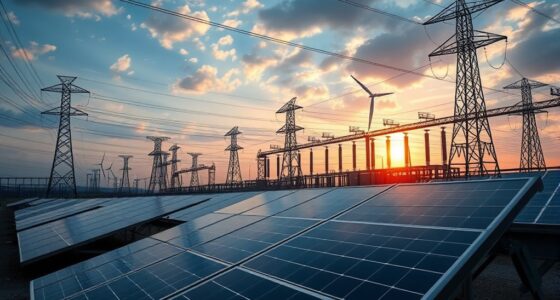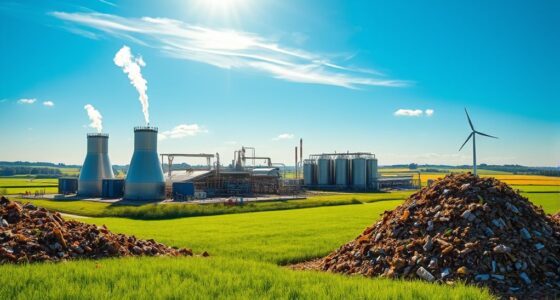Low-carbon fuels are essential for achieving net-zero emissions by 2050. They help decarbonize hard-to-electrify sectors, like heavy industry and transportation, which rely on alternatives like hydrogen and synthetic fuels. Despite high production costs and the need for new infrastructure, strong policy support and technological advancements can bridge these gaps. Investing in low-carbon options isn't just necessary; it's urgent. To understand how these fuels fit into integrated assessment and energy system models, keep exploring further.
Key Takeaways
- Low-carbon fuels are essential for achieving net-zero emissions by 2050, particularly in hard-to-electrify sectors like heavy industry and transportation.
- Hydrogen, ammonia, and synthetic fuels are key alternatives that complement electrification and meet high energy demands in aviation and maritime.
- Transitioning to low-carbon fuels faces challenges such as high production costs and the need for new infrastructure and technological advancements.
- Robust policy frameworks and international regulations are necessary to support the adoption and competitiveness of low-carbon fuels across various sectors.
- Significant annual investments and economic incentives are crucial to bridge cost gaps and facilitate large-scale production of low-carbon fuels.

As we strive for a net-zero future by 2050, low-carbon fuels emerge as vital players in decarbonizing hard-to-electrify sectors like heavy industry and transport. These fuels, including hydrogen, ammonia, and synthetic fuels, provide a diverse portfolio that complements the electrification pathway. While we often think of electric vehicles in light transport, heavy-duty vehicles and long-distance transport rely heavily on these low-carbon alternatives.
Hydrogen and ammonia are particularly significant due to their high energy density, making them ideal for long distances. Synthetic fuels, on the other hand, are gaining traction in aviation and maritime sectors, where electrification struggles to meet energy demands. Currently, 78.5% of global primary energy demand is met by fossil energy sources, which highlights the urgent need for transition to low-carbon fuels.
Hydrogen and ammonia's high energy density positions them as key solutions for long-distance transport, while synthetic fuels are crucial for aviation and maritime needs.
However, transitioning to low-carbon fuels comes with challenges. Investment in new infrastructure and technological advancements is essential, as current production costs are typically higher than traditional fossil fuels. To bridge this gap, economic incentives and strong regulatory support are crucial.
In heavy industry, low-carbon fuels like hydrogen are instrumental in decarbonizing processes such as steel and chemical manufacturing. The aviation and maritime sectors, with their high energy requirements, necessitate fuels like synthetic paraffin and ammonia to reduce emissions effectively.
By improving energy efficiency alongside these fuels, we can achieve deeper emission cuts, though we must overcome significant technological and cost hurdles in large-scale production.
A robust policy framework is needed to support the transition to low-carbon fuels across various sectors. Harmonized international regulations play a critical role, especially in aviation and maritime applications.
Considerable annual investment is required to facilitate this shift, estimated in the billions, which underscores the importance of public support and incentives to make low-carbon options more competitive.
Frequently Asked Questions
What Are the Main Types of Low Carbon Fuels?
When exploring low-carbon fuels, you'll encounter several main types.
Liquid biofuels like ethanol and biodiesel, renewable electricity from sources like solar and wind, and biomethane made from organic waste are key players.
Hydrogen, especially green hydrogen from renewable sources, also stands out.
Though natural gas and propane are fossil-based, they emit less than traditional fuels.
Each of these options plays a crucial role in reducing greenhouse gas emissions and promoting sustainability.
How Do Low Carbon Fuels Impact Air Quality?
Low carbon fuels significantly improve air quality by reducing harmful emissions like NOx and PM2.5.
By displacing traditional fossil fuels, you'll notice cleaner air and fewer pollutants in your environment.
This shift not only protects public health, preventing thousands of deaths annually, but also addresses disparities in pollution exposure among communities.
Adopting low carbon fuels contributes to a healthier urban atmosphere, benefiting everyone and promoting environmental equity.
What Are the Costs Associated With Low Carbon Fuel Production?
You might think low-carbon fuel production is straightforward, but the costs can be quite complex. Hydrogen production alone accounts for about 58% of synthetic fuel costs, influenced by the method used.
Advanced biofuels also have significant expenses, mainly from feedstocks and operational processes. As production scales up, costs can decrease due to economies of scale.
How Do Policies Influence Low Carbon Fuel Adoption?
Policies play a crucial role in influencing your adoption of low-carbon fuels. Tax credits and incentives can make these fuels more financially appealing.
Low-Carbon Fuel Standards encourage cleaner options by setting emissions targets. Additionally, federal support fosters innovation in biofuels, while stable tax policies provide certainty for businesses.
When you see immediate benefits through consumer-centric policies, like tax credits at purchase, you're more likely to choose low-carbon alternatives in your daily life.
What Role Do Consumers Play in Low Carbon Fuel Markets?
You play a crucial role in low-carbon fuel markets by driving demand with your choices. When you opt for cleaner fuels, you encourage companies to invest in sustainable options.
Your willingness to pay a premium for these fuels enhances brand reputations and stimulates innovation. Additionally, your feedback helps shape products and policies, while your purchasing decisions influence the adoption of new technologies, ultimately supporting a broader shift toward a more sustainable energy future.
Conclusion
So, as we gallivant towards a net-zero future, let's not forget our beloved low carbon fuels. They're like the eco-friendly superheroes of our energy saga, swooping in to save the day—while we all sip our lattes and scroll through social media. Who needs a complete overhaul of our lifestyles when we can just sprinkle some low carbon magic on our existing habits? After all, saving the planet can be just as easy as changing a light bulb, right?










